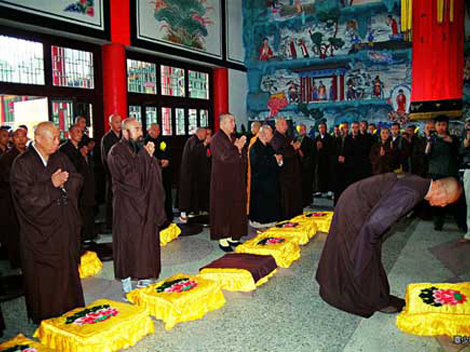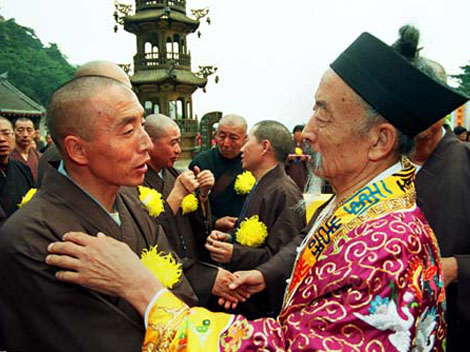
20km away from the southeast of Anshan City, Liaoning Province, Qianshan Mountain is one of the famous scenic spots in China. It is located in Northeast China, enjoying the fame of "Bright Pearls in Northeast China" together with Changbai Mountain in Jilin Province. Qianshan Mountain is the sacred land of Buddhism and Taoism. Qianshan Temple Music is divided into two types: Buddhist Music and Taoist Music. It is evolved from various Buddhist activities carried out in temple. Through constantly absorbing the essence of national folk music, Sanskrit Music in India and other types of sacred music, it had been matured and perfected by the Jin, Yuan, Ming and Qing Dynasties. Featuring fluent tunes, Qianshan Taoist Music has been spread for over one hundred years. Some of the opuses are beautiful and solemn, with intense religious styles.

Coexistence of Buddhism and Taoism on the same mountain has covered Qianshan Mountain with a mysterious vein. Musical instruments used to play Buddhist Music and Taoist Music in Qianshan Temple are similar, but the content and lasting appeal of their singing and recital are different.

Different from other types of temple music, Qianshan Buddhist Music is featured by brilliant rhythms, high-pitched tones, boorish and unconstrained melodies, and flaming emotions. Endowed with intense religious flavors and distinct local characteristics, Qianshan Buddhist Music is divided into vocal music and instrumental music. Vocal music is composed of two parts - Dhgaya Rhyme and Temporized Rhyme, with the former featuring accompaniment of percussion instruments, and the latter accompanied by wind pipe instruments and used to place "Flame Hole". Qianshan Buddhist Music is rich in singing and recital modes, including solo ("Zantou" or "Qiqiang"), joint recital, direct singing, Yunbai (the part where the traditional pronunciation of certain words is slightly different from the dialect), and so on. Most of the modes are led by 'Weinashi" (a monk in charge of rituals in temple) and joined by other monks.
New Northeast Rhyme is adopted to play Qianshan Taoist Music in all Taoist temples in Northeast China except for the one on Qianshan Mountain. Legend has it that New Northeast Rhyme was originated by two brothers surnamed "Kan" over one hundred years ago. Frustrated in their career, these two drama actors came to Qianshan Mountain and became a monk of Wuliang Abbey on the mountain. Under their life-long painstaking efforts, this type of music was created. The most distinct characteristics of New Northeast Rhyme are close linkage of musical passages, which presents as integral and indivisible wholeness. It is said that the two brothers could sing New Northeast Rhyme without any differences when sitting back to back at both sides of a huge rock. Both of them broke down and died from constant overwork in the end. Prevailing among Taoist followers in Northeast China before the emergence of New Northeast Rhyme was "Laoshan Rhyme" which was said to be introduced from Shandong Province. After its appearance, New Northeast Rhyme was spread among Taoist followers in Northeast China at a fast pace. It is adopted by temples of the Quanzhen Sect of Taoism in Northeast China. Qianshan Taoist Music is played by using such wind instruments as pan pipe, flute, single/dual duct and Chinese wind pipe as well as percussion instruments and musical instruments used in Buddhist or Taoist services, including bell, drum, big inverted bell, clank, clapper, bumping bell and wooden knocker.





